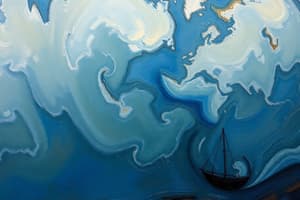Podcast
Questions and Answers
What is the name given to the horizontal movement of air from an area of high pressure to low pressure?
What is the name given to the horizontal movement of air from an area of high pressure to low pressure?
Wind
What is the name given to the effect that causes winds to bend to the west due to the Earth's rotation?
What is the name given to the effect that causes winds to bend to the west due to the Earth's rotation?
Coriolis effect
What is the name given to the boundary between two air masses?
What is the name given to the boundary between two air masses?
Front
Which of the following is the tool used to measure temperature?
Which of the following is the tool used to measure temperature?
Match each type of heat transfer with its corresponding description.
Match each type of heat transfer with its corresponding description.
Metals are good conductors of heat.
Metals are good conductors of heat.
What is the name given to the process of a substance changing from a liquid to a gas?
What is the name given to the process of a substance changing from a liquid to a gas?
The sun gives us energy in the form of electromagnetic waves.
The sun gives us energy in the form of electromagnetic waves.
What is the name given to the process of warming the Earth's surface by the atmosphere and clouds reflecting heat back to the surface?
What is the name given to the process of warming the Earth's surface by the atmosphere and clouds reflecting heat back to the surface?
Identify the strongest greenhouse gas among the options provided.
Identify the strongest greenhouse gas among the options provided.
What is the name of the tool used to determine relative humidity and dew point?
What is the name of the tool used to determine relative humidity and dew point?
What is the base of a cloud called?
What is the base of a cloud called?
Flashcards
Local Wind
Local Wind
Horizontal air movement from high to low pressure, caused by uneven heating.
Sea Breeze
Sea Breeze
A wind that blows from the ocean to the land during the day due to temperature differences.
Land Breeze
Land Breeze
A wind that blows from the land to the ocean during the night, caused by temperature differences.
Monsoons
Monsoons
Signup and view all the flashcards
Global Winds
Global Winds
Signup and view all the flashcards
Coriolis Effect
Coriolis Effect
Signup and view all the flashcards
Air Mass
Air Mass
Signup and view all the flashcards
Continental Air Mass
Continental Air Mass
Signup and view all the flashcards
Maritime Air Mass
Maritime Air Mass
Signup and view all the flashcards
Front
Front
Signup and view all the flashcards
Barometric Pressure Rule
Barometric Pressure Rule
Signup and view all the flashcards
Tornado
Tornado
Signup and view all the flashcards
Hurricane
Hurricane
Signup and view all the flashcards
Temperature
Temperature
Signup and view all the flashcards
Conduction
Conduction
Signup and view all the flashcards
Radiation
Radiation
Signup and view all the flashcards
Convection
Convection
Signup and view all the flashcards
Specific Heat
Specific Heat
Signup and view all the flashcards
Phase Changes
Phase Changes
Signup and view all the flashcards
Greenhouse Effect
Greenhouse Effect
Signup and view all the flashcards
Dew Point
Dew Point
Signup and view all the flashcards
Relative Humidity
Relative Humidity
Signup and view all the flashcards
Cloud Formation
Cloud Formation
Signup and view all the flashcards
Air Pressure
Air Pressure
Signup and view all the flashcards
Wind Direction
Wind Direction
Signup and view all the flashcards
Wind Speed
Wind Speed
Signup and view all the flashcards
Anemometer
Anemometer
Signup and view all the flashcards
Wind Vane
Wind Vane
Signup and view all the flashcards
Cyclone
Cyclone
Signup and view all the flashcards
Anticyclone
Anticyclone
Signup and view all the flashcards
Study Notes
Meteorology Review
- Winds move from high pressure to low pressure.
- Winds are caused by unequal heating of Earth's surface.
- Wind names are based on their origin.
Local Winds
-
Sea Breeze:
- Occurs during the day.
- High pressure over the ocean (cooler temperatures).
- Low pressure over land (warmer temperatures).
- Cooler air from the ocean moves towards land.
-
Land Breeze:
- Occurs at night.
- High pressure over land (cooler temperatures).
- Low pressure over the ocean (warmer temperatures).
- Cooler air from land moves towards the ocean.
Monsoons
- Larger scale versions of land and sea breezes.
- Characterized by seasonal shifts in wind direction.
Global Winds
- Driven by unequal heating of Earth's surface.
- High pressure at poles (cool, sinking air).
- Low pressure at equator (warm, rising air).
- Coriolis effect causes winds to deflect.
- Winds in the northern hemisphere bend to the west.
Air Masses
- Large bodies of air classified by temperature and humidity.
- Moisture Content:
- Continental (c) - dry, forms over land.
- Maritime (m) - wet, forms over the ocean.
- Temperature:
- Tropical (T) - warm, forms near the equator.
- Polar (P) - cold, forms near the poles.
Fronts
- Boundary between two air masses.
Station Models
- Used to display weather data on maps.
- Include data like temperature, pressure, precipitation, and wind.
Weather Variables
- Temperature: the measure of kinetic energy; measured using thermometers (Celsius, Fahrenheit, Kelvin scale)
Severe Weather
- Tornadoes: Violent, rotating columns of air that touch the ground. Develop rapidly over land.
- Hurricanes: Tropical storms with extremely fast winds that form over warm water.
Heat
- Transfer of energy
- Types include conduction, convection, and radiation
Electromagnetic Spectrum
- Distribution of different wavelengths of energy
- Forms part of radiation.
- Includes infrared, visible light, and ultraviolet light
Greenhouse Effect
- Natural process warming the Earth.
- Gases in atmosphere trap heat.
- Important greenhouse gases include: CO2, water vapor, and methane.
Relative Humidity and Dew Point
- Relative humidity - amount of water vapor in air compared to the maximum possible.
- Dew point - temperature at which air becomes saturated with water vapor.
Clouds
- Form through condensation of water vapor in the atmosphere.
- Base of a cloud is at the altitude where the air temperature reaches the dew point.
Air Pressure
- Pressure exerted by the atmosphere.
- Decreases with altitude.
Pressure Systems
- High-pressure systems: Clear, dry weather, descending air.
- Low-pressure systems: Cloudy, wet weather, rising air.
Wind
- Horizontal movement of air from areas of high pressure to low pressure.
- Measured by wind vanes and anemometers (wind speed).
Studying That Suits You
Use AI to generate personalized quizzes and flashcards to suit your learning preferences.




